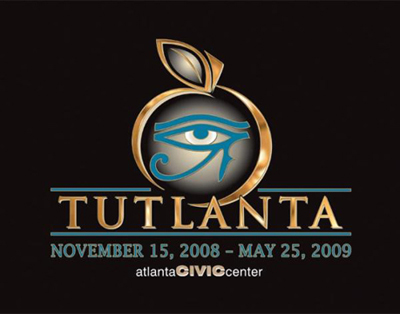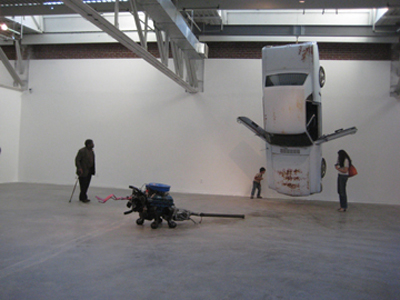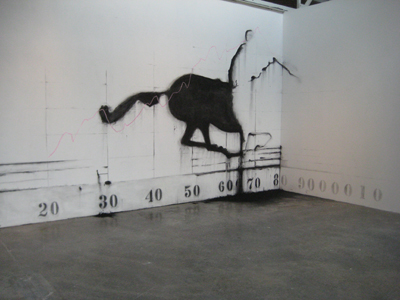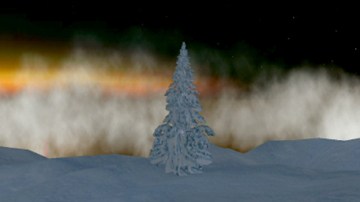Beyond Tutlanta…

I’m writing from Atlanta. A newcomer, I have just learned gardenias are a sign of summer. Apparently, so are Monet’s Water Lilies, which will be temporarily transplanted from MoMA to the High Museum during what promises to be hot days ahead.
Sadly, I still know more about Atlanta’s seasonal horticulture than I do about the local art scene. So having outed my ignorance and in search of an anecdote, I invite you to join me over the course of the next two weeks in finding out what lies beyond the borders of Tutlanta.
The very notion of locality is a complicated one, and my experiences this past Saturday reveal just how fraught the label “regionalism” has become. I spent the day wandering through the Westside Art District, whose central gem is the Atlanta Contemporary Art Center, known as “the Contemporary.” While there, I was treated to a talk by Atlanta-based artist Mark Wentzel, who spoke about his commissioned installation, Morale Hazard. An intersection of moments and places of both personal and national significance, Wentzel’s triadic piece provides an apt springboard for thinking about geographic identity.

Mark Wentzel, "Morale Hazard" (detail), 2009. Courtesy the Atlanta Contemporary Art Center
The most dramatic element of the work, a 1965 powder blue Ford Mustang, hangs suspended from the ceiling, recalling Wentzel’s childhood in the Detroit area while also speaking to the function of the Contemporary’s site as a former Atlanta truck repair facility and to the current state of the U.S. auto industry (an insurance term, Morale Hazard refers to an increased indifference to risk by the insured—enabled, ironically, by insurance). As if flung forth from the upended vehicle, the Mustang’s engine crawls across the gallery space, morphing into a four-legged form, recalling the Aztec Xoloitzcuintle or an Esquincle, the Mexican hairless dog beloved by DIA star artist Diego Rivera.

Mark Wentzel, "Morale Hazard" (detail), 2009. Courtesy the Atlanta Contemporary Art Center
The third element of Morale Hazard is an Eadweard Muybridge-inspired velvety charcoal drawing gracing two walls. The eroding figure of horse and rider glides along a graph, while a pink line marks a mountainous profile of upward production. Muybridge’s famous photographs of a horse in motion (proving once and for all horses do simultaneously lift all four legs off the ground) resulted from “an exceptionally felicitous alliance” between the photographer and former California governor, railroad baron, horse racer, and founder of a small college bearing his name, Leland Stanford. Wentzel is especially intrigued by the fact that it was Stanford who in 1869 drove the “Golden Spike” into the dusty soil at Promontory Summit, Utah, creating the first transcontinental railroad—a moment which helped render the flesh and blood Mustang moot.
Hearing Wentzel speak, I couldn’t help but think how the merger of east and west rails also signaled the end of American frontierism, famously lauded by Frederick Jackson Turner as central to American identity. Upon its “closure,” the Frontier became an imagined place for nostalgic longing, a sentiment that fanned imperialist desires. A kindred strain of nostalgia prevents the ’65 Mustang from crashing to the floor. But to whom does such nostalgia belong and what dangers might it hazard? Meccas of car culture, Detroit and Atlanta are woefully deprived of infrastructure and mass transit (although the latter’s MARTA system is not without merits); two cities where wars over civil liberties and American identity have been bitterly waged. I couldn’t help noticing 1968 is cited by Wikipedia as the first instance when the term “Morale Hazard” was used by Casualty Insurance. What hangs in the balance?
Romance for real and imagined places are in full force in Elsewhere, curated by Baltimore-born, New York-based artist Shinique Smith. The show is on view at Saltworks gallery, a twenty-minute walk from the Contemporary through streets lined with refurbished industrial buildings and past a sign marking the surrender of Atlanta on September 2, 1864.

Chistine Bailey, "Kanin" (video still), 2007. Courtesy Saltworks Gallery
Upon entering Elsewhere, a visitor is invited to handle postcards and travel books which have been altered by the artist, Jane Benson. New York, Berlin, and London have become verdant passages of paint, devoid of recognizable landmarks and their geographic specificity. In Kanin, a snowy Second Life landscape populated by avatars, Christine Bailey draws on romantic tropes of painters past. Perhaps because Wentzel’s work was still fresh, I was comforted by Bailey’s vision of a paradoxically nostalgic future as an alternative to the darker, virtual frontier detailed by science fiction prophecies of the world to come. Fittingly, like Smith, all of the artists in Elsewhere do indeed hail from elsewhere. But then again, notes one of the rare natives, Saltwork’s director Brian Holcombe, so do most Atlantans.
And who says locals always know best? The value of insider knowledge is comically put to the test in another work up on view at the Contemporary, Rae Goodwin’s “I Refuse to Hike this Way” (2008-2009). An avid solo hiker living in Kentucky, Goodwin sought advice from locals attending the annual Hillbilly Festival. Scrawled in response to the question “I like to take hikes by myself …could you give me some advice?” are a range of germane and obscure responses, some of which, in closing, I’d like to share with you:
“Wear pants”
“You’re stupid”
“Carry a cell phone”
“Take gun”
“Don’t wear flip flops”
“Don’t drink beer and go to the Center Creek…”
“Be aware of other people – don’t be trusting”
“Pee downhill”




Pingback: Interview: Fahamu Pecou | Art21 Blog